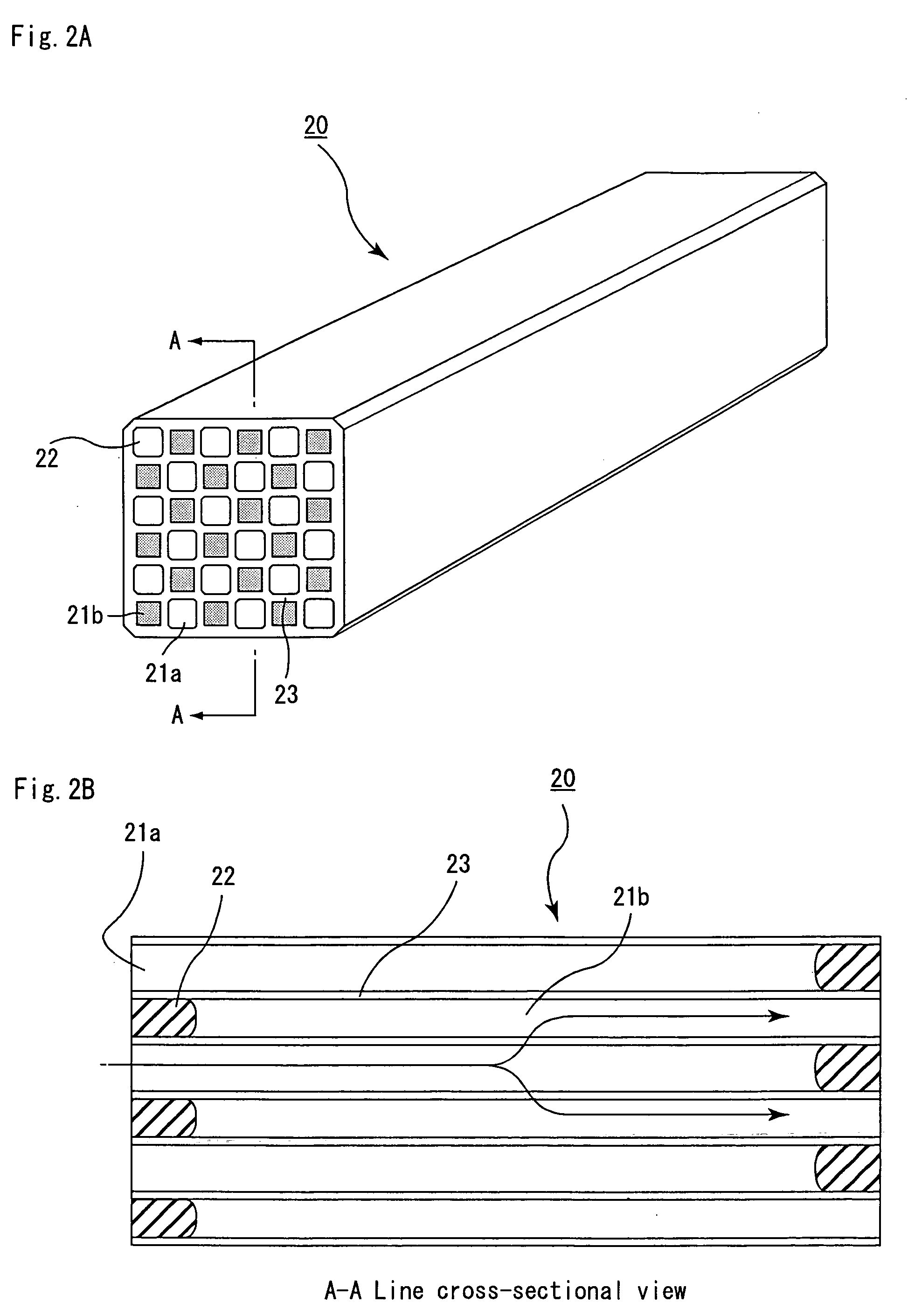Honeycomb structured body and exhaust gas purifying device
a technology of structured body and exhaust gas, which is applied in the direction of filtration separation, physical/chemical process catalysts, separation processes, etc., can solve the problems of serious problems, harmful to the environment and the human body, and achieve the effect of improving the heat stress-resistance of the honeycomb structured body
- Summary
- Abstract
- Description
- Claims
- Application Information
AI Technical Summary
Benefits of technology
Problems solved by technology
Method used
Image
Examples
example 1
[0218] (1) Powder of α-type silicon carbide having an average particle diameter of 11 μm (60% by weight) and powder of β-type silicon carbide having an average particle diameter of 0.5 μm (40% by weight) were wet-mixed. To 100 parts by weight of the resulting mixture, 5 parts by weight of an organic binder (methyl cellulose) and 10 parts by weight of water were added and kneaded to obtain a mixed composition. Then, a small amount of a plasticizer and a lubricant was added to the mixed composition and further kneaded, and thereafter the resulting product was extrusion-molded, whereby a raw formed body wherein a cross-section of a large-capacity through hole is in an octagonal shape and a cross-section of a small-capacity through hole is in a quadrangular shape (substantially square-shape) as shown in FIGS. 4A to 4D was formed.
[0219] Next, the raw formed body was dried by the use of a microwave dryer and the like to obtain a ceramic dried body. Then, predetermined through holes in th...
examples 21 to 23
[0227] (1) Powder of α-type silicon carbide having an average particle diameter of 30 μm (80% by weight) and powder of metallic silicon having an average particle diameter of 4 μm (20% by weight) were wet-mixed. To 100 parts by weight of the resulting mixed powder, 6 parts by weight of an organic binder (methyl cellulose), 2.5 parts by weight of a surfactant (oleic acid), and 24 parts by weight of water were added and kneaded to obtain a raw material paste.
[0228] Then, an extrusion forming machine was filled with the raw material paste, and a raw formed body having almost the same shape as that of the porous member 30 shown in FIGS. 3A and 3B was formed at an extrusion rate of 10 cm / minute.
[0229] Next, the resulting raw formed body was dried by the use of a microwave dryer to obtain a dried body. Thereafter, predetermined through holes in the dried body were filled with a filler paste having the same composition as that of the raw formed body, and dried again by using the dryer. T...
examples 24 to 26
[0235] A degreased body was prepared in accordance with the same manner as that of Examples 21 to 23 except that a metallic silicon powder having 4 μm average particle diameter was wet-mixed to prepare a raw material paste. The degreased body was heated under the condition of at 1000° C. for 2 hours in an argon atmosphere to manufacture a porous member having 45% porosity, 10 μm average pore diameter, and 34.3 mm×34.3 mm×305 mm dimension. The porous members were bound in accordance with the same manner as that of Examples 21 to 23 to manufacture a filter of a cylindrical honeycomb structured body having 190 mm diameter.
PUM
| Property | Measurement | Unit |
|---|---|---|
| porosity | aaaaa | aaaaa |
| porosity | aaaaa | aaaaa |
| pore diameter | aaaaa | aaaaa |
Abstract
Description
Claims
Application Information
 Login to View More
Login to View More - R&D
- Intellectual Property
- Life Sciences
- Materials
- Tech Scout
- Unparalleled Data Quality
- Higher Quality Content
- 60% Fewer Hallucinations
Browse by: Latest US Patents, China's latest patents, Technical Efficacy Thesaurus, Application Domain, Technology Topic, Popular Technical Reports.
© 2025 PatSnap. All rights reserved.Legal|Privacy policy|Modern Slavery Act Transparency Statement|Sitemap|About US| Contact US: help@patsnap.com



